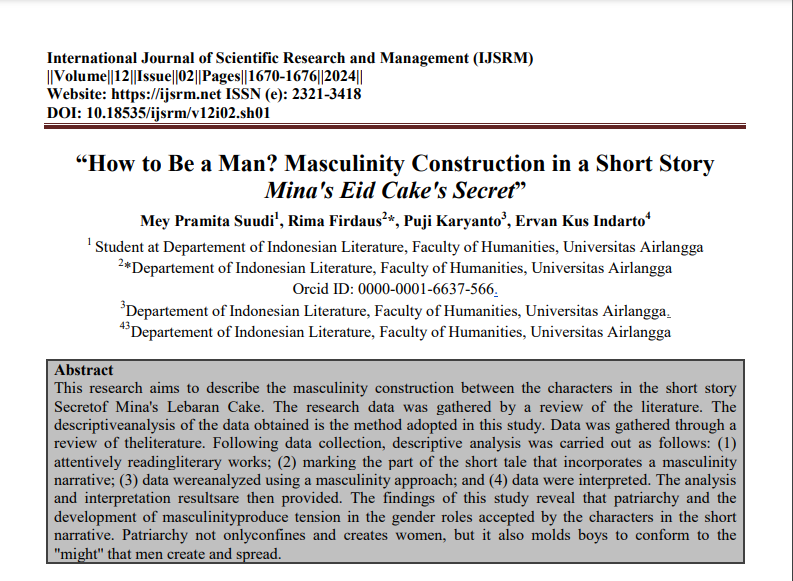
Submission to VIJ 2024-02-20
Keywords
- Construction of Masculinity, Gender role conflict, Humans, Flood
Copyright (c) 2024 Rima Firdaus, Mey Pramita Suudi, Puji Karyanto, Ervan Kus Indarto

This work is licensed under a Creative Commons Attribution 4.0 International License.
Abstract
This research aims to describe the masculinity construction between the characters in the short story Secret of Mina's Lebaran Cake. The research data was gathered by a review of the literature. The descriptive analysis of the data obtained is the method adopted in this study. Data was gathered through a review of the literature. Following data collection, descriptive analysis was carried out as follows: (1) attentively reading literary works; (2) marking the part of the short tale that incorporates a feminist narrative; (3) data were analyzed using a masculinity approach; and (4) data were interpreted. The analysis and interpretation results are then provided. The findings of this study reveal that patriarchy and the development of masculinity produce tension in the gender roles accepted by the characters in the short narrative. Patriarchy not only confines and creates women, but it also molds boys to conform to the "might'' that men create and spread.
References
- Connell, R. W. (1993). The big picture: Masculinities in recent world history. Theory and society, 597-623.
- Riswanto, A., Saribanon, E., & Gaffar, V. (2018). The importance of the cultural and gender outlook on consumer behavior studies: An Indonesian perspective. Arthatama, 2(1), 35-49.
- Zhigang, H. (2009). New era writers: aesthetic choices and the generation gap. Social Sciences in China, 30(2), 85-100.
- Bielskis, A. (2022). Literature as an educator: Ethics, politics and the practice of writing in Thomas Mann's life and work. Journal of Philosophy of Education, 56(2), 265-280.
- Hume, K. (2014). Fantasy and Mimesis (Routledge Revivals): Responses to Reality in Western Literature. Routledge.
- Ghifari, A., Santosa, B. T., & Hardiyanti, D. (2021). Horizon of Expectation on Popular Lyrical Poetry: Jauss Reader Response Perspective. Horizons, 6(2).
- Jauss, H. R. (2022). Literary history as a challenge to literary theory. In New directions in literary history (pp. 11-41). Routledge.
- Beverley, J. (1989). The margin at the center: On" testimonio"(testimonial narrative). Modern Fiction Studies, 35(1), 11-28.
- Cortazzi, M. (1994). Narrative analysis. Language teaching, 27(3), 157-170.
- Oatley, K. (1999). Meetings of minds: Dialogue, sympathy, and identification, in reading fiction. Poetics, 26(5-6), 439-454.
- Lothe, J. (2000). Narrative in fiction and film. An Introduction. 0xford: OUP.
- Adshead, C. (2019). Becoming Dracula: Translating the Transforming Vampire Myth in 18th and 19th Century Literature. LUX: Undergraduate Journal of Literature and Culture, 7.
- Williams, L. (2015). 3 When the Woman Looks. In The Dread of Difference, 2nd ed. Gender and the Horror Film (pp. 17-36). University of Texas Press.
- Lahdji, R. F. (2015). Objectification of women and the body: discourse on women's bodies in popular dangdut song lyrics 2000-2013. Unair: FIB, Master of Literature and Cultural Studies.
- Firdaus, R., Datau, R. O., Bramantio, B., Afdholy, N., & Santoso, L. (2023). The Politicization of Islam: Criticism of Patrimony and the Tradition of Forced Marriage in the Novels Woman with a Turban and the Holy Woman. International Journal of Multicultural and Multireligious Understanding, 10(8), 314-324.
- Elmhirst, R. (2007). Tigers and gangsters: Masculinities and feminized migration in Indonesia. Population, Space and Place, 13(3), 225-238.
- Jinanto, D. (2017). Belle Dalam Dua Dunia: Animasi Beauty And The Beast Tahun 1991 dan Film La Belle Et La Bête Tahun 2014. Urban: Jurnal Seni Urban, 1(2), 133-148.
- Bhakti, M.R.M. (2017). Representation Of Masculinity In The Comic Pandji Tengkorak By Hans Jaladara A Semiotic Study (Doctoral Dissertation, Jakarta State University).
- Sholikha, M. (2020). Masculinity in the Novel Kembara Rindu by Habiburrahman El Shirazy. Bapala, 7(1), 1-17.
- Ibrahim, AI (2013). Maskulinitas dalam Novel Keluarga Permana Karya Ramadhan KH. Metalingua: Jurnal Penelitian Sastra, 6(2).
- Intan, T. (2021). Stereotip Gender dan Wacana Maskulinitas dalam Novel Di Tanah Lada Karya Ziggy Zezsyazeoviennazabrizkie. Yinyang: Jurnal Studi Islam Gender dan Anak, 71-88.
- Drianus, O. (2019). Maskulinitas hegemonik: Wacana Relasi Gender dalam Tinjauan Psikologi Sosial. Psikosofia: Jurnal Psikologi, Agama, dan Kemanusiaan, 1 (1), 36-50.
- Bussey, K., & Bandura, A. (1992). Self-regulatory mechanisms governing gender development. Child Development Research Society, 63(5), 1236–1250. https://doi.org/10.1111/j.1467-8624.1992.tb01692.x.
- Flood, M. (2002). Between Men and Masculinity: An Assessment of the Term “Masculinity” in Recent Scholarship on Men, in Pearce, S. & Muller, V. (eds). Eyes on the Next Millennium: A Study of Masculinity. Bentley: Black Swan Press.
- Aliurida, 2022. “Cerpen Rahasia Kue Lebaran Mina”. https://www.kompas.id/baca/cerpen-hiburan/2022/05/14/rahasia-kue-lebaran-mina.
- Tenu, Permana, D. (2020). Marginalisasi Perempuan Dalam Cerpen “Inem” Karya Pramoedya Ananta Toer (Sebuah Kajian Feminisme).Riswanto, A., Saribanon, E., & Gaffar, V. (2018). The importance of the cultural and gender outlook on consumer behavior studies: An Indonesian perspective. Arthatama, 2(1), 35-49.
- Beauvoir, S. (2014). The second sex. In Classic and Contemporary Readings in Sociology (pp. 118-123). Routledge.
- Firdaus, Rima. (2022). Spirit Doll Phenomenon: Breaking the Construction of Masculinity?.optica.id
- Soedarwo, V. S. D. (2014). Political ideology meaning and patriarchal ideology of female politicians in Indonesia: A case in Malang. Procedia Environmental Sciences, 20, 486-495.
- Sultana, A. (2010). Patriarchy and women's subordination: a theoretical analysis. Arts Faculty Journal, 1-18.
- Henderson, M. G. (2013). Speaking in tongues: Dialogic dialectics, and the black woman writer's literary tradition. Feminists theorize the political (pp. 144-166). Routledge.
- Eagly, A. H., & Carli, L. L. (2004). Women and men as leaders. The nature of leadership, 279-301.
- Nilan, P. (2009). Contemporary masculinities and young men in Indonesia. Indonesia and the Malay World, 37(109), 327-344.
- Setiyono, J. (n.d.). Kajian Feminisme Dalam Cerpen Lelaki Ke-1000 Di Ranjangku Karya Emha Ainun Najib.
- Bazerman, C. (2004). Intertextualities: Volosinov, Bakhtin, literary theory, and literacy studies. Bakhtinian perspectives on language, literacy, and learning, 53-65.
